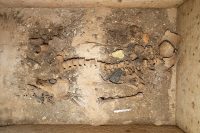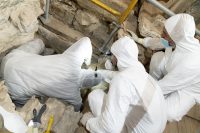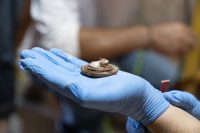 Archaeologists have discovered the intact tomb of a prominent woman under Episkopi Monument on the Cyclades island of Sikinos. She was buried with fine jewelry including gold bracelets, finger rings, a necklace and a high relief cameo brooch. Other goods found in the grave include glass and metal vases. Of no monetary value but immense archaeological value is organic material believed to be textile fragments from her burial garments.
Archaeologists have discovered the intact tomb of a prominent woman under Episkopi Monument on the Cyclades island of Sikinos. She was buried with fine jewelry including gold bracelets, finger rings, a necklace and a high relief cameo brooch. Other goods found in the grave include glass and metal vases. Of no monetary value but immense archaeological value is organic material believed to be textile fragments from her burial garments.
 The Episkopi Monument was originally a Roman-era mausoleum built in the 3rd century A.D. and later converted into a temple to Pythian Apollo. The dome was added in the 5th century when the temple was converted into a Christian church. The Byzantine church was severely damaged in an earthquake, but much of it remains standing. Its height and long history of usage from antiquity through the Middle Ages make it unique in Greece.
The Episkopi Monument was originally a Roman-era mausoleum built in the 3rd century A.D. and later converted into a temple to Pythian Apollo. The dome was added in the 5th century when the temple was converted into a Christian church. The Byzantine church was severely damaged in an earthquake, but much of it remains standing. Its height and long history of usage from antiquity through the Middle Ages make it unique in Greece.
 Because of its eventful past, the monument is in regular need of restoration. A team of experts from the Ministry of Culture and Sports and the Cyclades Ephorate of Antiquities has been working on an extensive restoration project since last year. It was during the restoration work that the grave was discovered in a concealed section of the site’s underground crypt. The rectangular stone tomb was likely deliberately hidden to keep its owner and her treasures out of reach of looters.
Because of its eventful past, the monument is in regular need of restoration. A team of experts from the Ministry of Culture and Sports and the Cyclades Ephorate of Antiquities has been working on an extensive restoration project since last year. It was during the restoration work that the grave was discovered in a concealed section of the site’s underground crypt. The rectangular stone tomb was likely deliberately hidden to keep its owner and her treasures out of reach of looters.
 The burial has not been dated yet, but the artifacts suggest it is from late antiquity around the time when the mausoleum was built. Archaeologists think the woman’s burial may be the one for which the large mausoleum was erected in the first place. Besides her obvious wealth, the importance of the stone coffin and the hidden placement, another clue that points towards the funerary structure having been built to mark her tomb is an single-word inscription discovered in the mausoleum. It is the female name “Νεικώ” (Neiko). Perhaps Neiko has now been found.
The burial has not been dated yet, but the artifacts suggest it is from late antiquity around the time when the mausoleum was built. Archaeologists think the woman’s burial may be the one for which the large mausoleum was erected in the first place. Besides her obvious wealth, the importance of the stone coffin and the hidden placement, another clue that points towards the funerary structure having been built to mark her tomb is an single-word inscription discovered in the mausoleum. It is the female name “Νεικώ” (Neiko). Perhaps Neiko has now been found.
I read someone the other day working himself up into a fine fit of fake righteous indignation over this sort of thing – archaeologists as grave robbers, how would you feel if it were your granny?, blah, blether, blah.
I suppose we need some pompous ass to say that, au contraire, only by archaeologists finding the tomb has dear Seiko been made immortal.
Her name Νεικώ means -at least as far as I could tell- that lady was either up for strife herself, or that she gave reason to do so for others.
Of course, I’d like to see that necklace restored in full splendor, and would like to know what that amber-colored device next to it might be. Also, could that ‘cameo brooch’ possibly depict a toad?
:hattip:
If that were my granny, I would be very impressed that she died 1600 odd years before giving birth to my father/mother. 😉
Why are “textile fragments” so often sidelined in favor of jewelry and weapons? The technology and design involved in weaving is complicated and fascinating. Full disclosure – I am a weaver!
Mariam, too funny! It is the profile of a woman with an elaborate hair style. I am also curious about the textiles.
He he 😉 , I am beginning to think that what I identified as amber colored object, is in fact the backside of that toad-/ styled woman brooch.
Shakespeare’s As You Like It (1599), in Act 2, Scene 1, lines 12 through 14:
————————————-
“Sweet are the uses of adversity;
Which, like the toad, ugly and venomous,
Wears yet a precious jewel in his head.”
According to Pliny. Nat. 32.18:
“THE SEA-FROG: SIX REMEDIES. THE RIVER-FROG: FIFTY-TWO REMEDIES. THE BRAMBLE-FROG: ONE REMEDY. THIRTY-TWO OBSERVATIONS ON THESE ANIMALS. … The Greeks call them “phryne [φρύνη]:” they are the largest in size of all the frogs […] and are full of poison. […] also that by throwing into boiling water a small bone that is found in their right side, the vessel will immediately cool, and the water refuse to boil again until it has been removed. This bone, they say, may be found by exposing a dead bramble-frog to ants, and letting them eat away the flesh: after which the bones must be put into the vessel, one by one. […] This bone, it is said, has the property of assuaging the fury of dogs, and, if put into the drink, of conciliating love and ending discord and strife.” 😮
And here, My Dear Friends, our good old toad Νεικώ comes into play… 😆